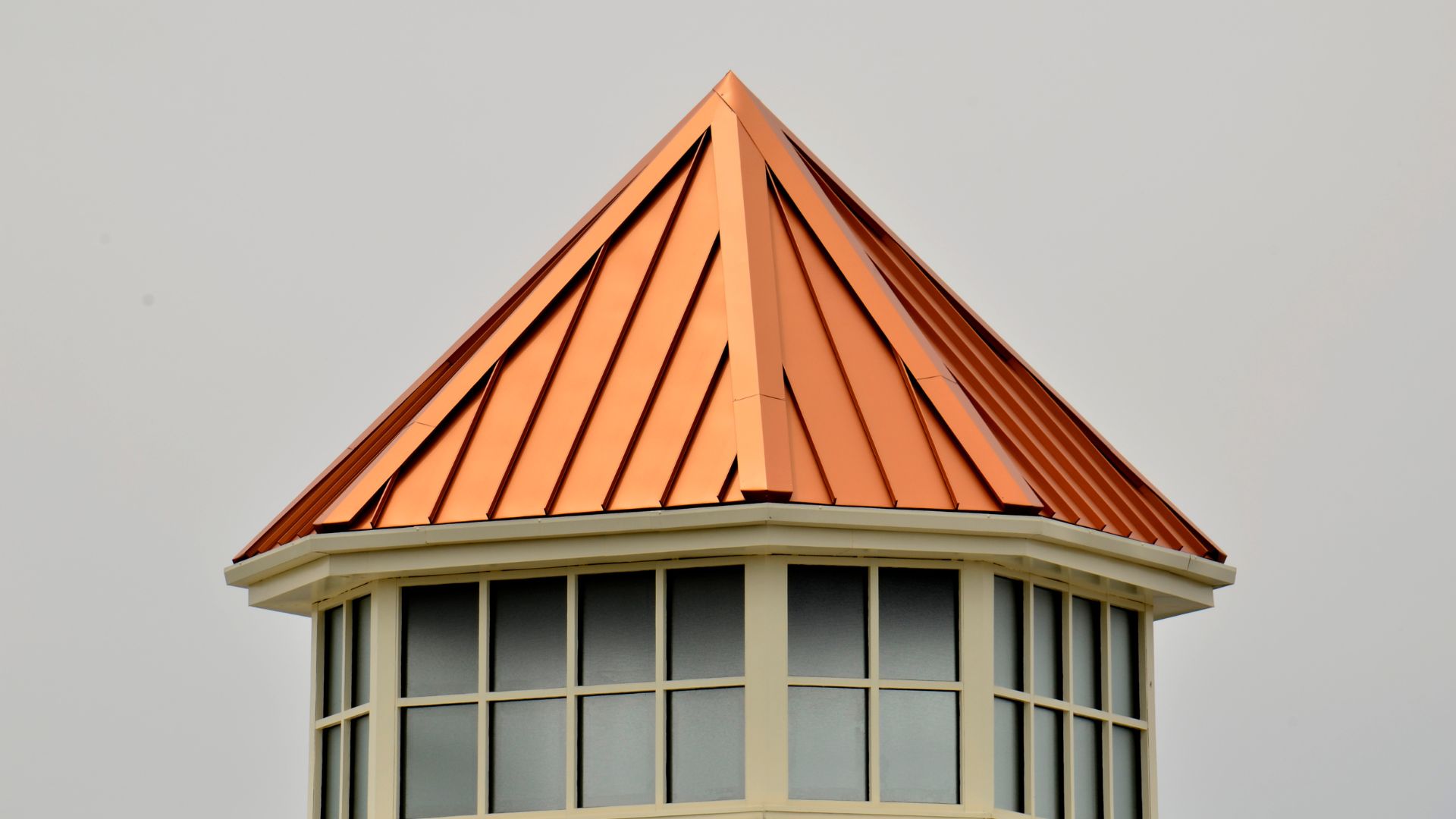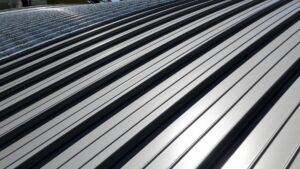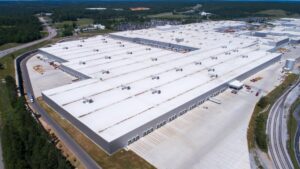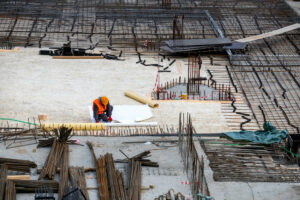Choosing the right roofing material can be a tough decision for commercial and industrial property managers. Copper has long been cherished as a durable and elegant option for roofs.
In this post, we’ll explore how copper metal roofs perfectly blend tradition with modern architecture, offering solutions that are both timeless and innovative. Discover why copper could be your best choice.
Key Takeaways
- Copper has been a top choice for roofing for thousands of years because it’s durable and looks great. It was first used in ancient civilizations like Egypt and Rome, showing its long history.
- Today, architects use copper in modern buildings because it can handle different designs, from classic to contemporary. Its ability to reflect sunlight helps save on cooling costs, making it energy-efficient.
- Copper roofs develop a green patina over time that protects them from corrosion. This natural aging process adds unique beauty and character to buildings while ensuring the roof lasts longer with minimal upkeep.
- These roofs are also good for the environment since they’re 100% recyclable. Using copper can help new buildings get LEED points, making them more sustainable.
- Despite being an old material, copper meets today’s architectural needs by combining tradition with modern technology. It offers not just style but practical benefits like low maintenance, protection from lightning strikes, and enhancing building safety through RF shielding.
Copper Roofs: A Historical Perspective

Copper has crowned buildings for centuries, showcasing its strength and beauty. From ancient temples to historic landmarks, this metal has played a pivotal role in architecture across the ages.
Ancient Uses
Ancient civilizations recognized the value of copper for its durable and corrosion-resistant properties. Egyptians and Romans were among the first to use this metal, notably in roofing materials, demonstrating an early appreciation for its longevity and aesthetic appeal.
This tradition set a foundation for copper’s role in architecture, establishing it as a preferred choice due to its weather resistance and minimal maintenance needs.
Dating back at least ten thousand years, copper roof cladding was not only the first metal widely used in building construction but also a hallmark of European medieval architecture.
Its ability to withstand atmospheric corrosion made it an integral part of historical buildings that still stand today. These ancient applications underline copper’s timeless elegance and structural integrity, qualities highly valued in modern architectural designs.
Modern Adaptations
Moving from its ancient applications, copper now shines in the realm of contemporary architecture. Commercial property managers, industrial property managers, and facility owners admire copper for more than its timeless beauty.
Today’s buildings feature copper roofing systems, flashings, rain gutters, and wall cladding due to their striking appearance and unmatched durability.
Builders favor copper for modern projects because it combines elegance with practical benefits like low maintenance and corrosion resistance. This metal adapts seamlessly into designs ranging from traditional to minimalist styles.
It enhances energy efficiency by reflecting sunlight, reducing cooling costs in the process. Architects also value its natural ability to develop a protective patina that shields against environmental damage over years.
Aesthetics and Elegance of Copper Roofs

Copper roofs add a touch of class and sophistication to any building. Their gleaming surface catches the eye, making structures stand out with elegance.
Timeless Appeal
Copper roofs carry a sense of prestige that transcends time, seamlessly merging with both traditional and modern architectural styles. This material not only enhances the visual appeal of buildings but also brings a piece of history to life, making structures stand out with elegance.
Its unique patina development over time adds character and beauty, ensuring that each roof is distinct and full of personality.
Architects and designers favor copper for its versatility in design, allowing it to adapt to various themes from classic European elegance to sleek contemporary lines. The metal’s natural properties contribute to energy savings by reflecting light and reducing heat absorption.
As a result, buildings sport an exterior that is as functional as it is aesthetically pleasing, underlining copper’s role in promoting sustainable building practices without sacrificing style.
Versatility in Design
Copper roofing offers endless possibilities for innovative and creative designs. Its malleability and flexibility allow architects to shape it into unique styles that match any architectural vision, from traditional to modern.
The material’s adaptability means that it suits a wide range of building types, including commercial and industrial properties managed by you.
Designers can choose from various copper finishes, allowing the metal to blend seamlessly with other architectural elements. Whether aiming for a sleek contemporary look or a classic aesthetic, copper’s visual appeal adds significantly to the versatility in design.
This makes copper not just a durable choice for roofing and cladding but also an aesthetically versatile option that enhances the overall appearance of your property.
Durability and Longevity of Copper Roofs
Copper roofs withstand harsh weather, offering unmatched durability. Their longevity outshines other materials, lasting for decades with minimal upkeep.
Corrosion Resistance
Copper stands out as an architectural metal due to its exceptional corrosion resistance. This noble metal effortlessly combats most corrosive environmental conditions, ensuring the roof’s durability and longevity.
Its ability to resist attacks well under various weather conditions makes it a reliable choice for commercial and industrial property managers looking for long-lasting roofing materials.
Over time, copper develops a natural patina that acts like a protective shell. This patina not only adds aesthetic value but also contributes significantly to the roof’s resilience against elements, further cementing copper’s role in green building practices.
Property owners can trust in copper roofing to maintain its integrity and shield against acid rain, reducing maintenance needs and enhancing the lifecycle of the structure without compromising on energy efficiency or recyclability.
Low Maintenance
Copper roofs stand out for their low maintenance costs, making them an appealing choice for commercial and industrial property managers. This material maintains its integrity over decades with minimal upkeep required.
It resists corrosion naturally, meaning it doesn’t need frequent replacements or repairs. Facility owners benefit greatly from this cost-effective roofing solution as it reduces the ongoing expenses typically associated with roof maintenance.
Thanks to their durable nature, properly installed copper roofs rarely call for attention beyond basic care, further emphasizing their efficiency and reliability in architectural applications.
This aspect ensures that facility managers can focus more on other aspects of building management without worrying about constant roof issues. Moving forward, exploring the durability uncovered reveals just how long metal roofs last, highlighting another key advantage of choosing copper for roofing needs.
Durability Uncovered: How Long Do Metal Roofs Last?
Metal roofs stand as a testament to durability and longevity in the realm of roofing materials, often surpassing 50 years of service. This impressive lifespan can reach up to 70 years for certain metals like copper, which is known not only for its resistance to corrosion but also for its minimal maintenance needs.
Property managers and facility owners seeking a long-lasting solution will find metal roofing, especially copper variants, an excellent investment that combines historical elegance with modern performance.
Selecting the right metal roof can dramatically influence the lifespan of your building’s covering. Copper roofs, notable for their potential to last over two centuries, provide a clear example of how choosing high-quality materials pays off in terms of both durability and architectural value.
Despite copper’s susceptibility to dents due to its softness, proper installation and care ensure that such minor issues do not compromise the roof’s overall longevity or functionality.
For those prioritizing sustainability along with endurance, metal roofs’ recyclable nature makes them an even more attractive option within today’s eco-conscious construction practices.
Sustainability of Copper Roofs
Copper roofs stand out as a green choice for buildings due to their high recyclability. They contribute significantly to reducing energy consumption and waste in the construction industry.
Recyclability
Copper roofing stands out in the world of sustainable design. It impresses with its 100% recyclability rate, making it a prime choice for eco-conscious commercial and industrial property managers.
This remarkable feature ensures that copper not only serves as a durable roofing material but also contributes significantly to waste reduction and supports the circular economy.
Many copper roofs boast up to 75% recycled materials at their core, underlining the metal’s integral role in minimizing environmental impact. Facility owners looking to enhance their buildings’ energy efficiency and sustainability can rely on copper’s recyclable nature.
This commitment to using recycled materials highlights how traditional materials like copper remain vital in modern green building practices, aligning with LEED certification goals and promoting lower energy consumption through cool roofing technologies.
Energy Efficiency
Transitioning from the recyclable nature of copper roofs to their role in energy efficiency, it’s crucial to understand how they contribute to reducing operational costs. Metal roofs, including those made of copper, reflect sunlight more effectively than traditional asphalt shingles.
This reflection minimizes heat absorption during hot summer months, leading to lower air conditioning needs and substantial cost savings for facility owners. Additionally, the thermal properties of copper improve energy distribution across rooftops, enhancing overall building energy efficiency.
Copper roofing systems not only offer aesthetic appeal but also play a significant role in environmental sustainability through their energy-efficient features. By reflecting sunlight and efficiently distributing heat due to its excellent thermal conductivity, copper helps maintain optimal temperatures inside buildings.
As a result, property managers can expect reduced energy consumption and lower utility bills. These benefits support the initiative towards green building practices and make copper an attractive choice for modern architectural projects aiming for both style and substance.
Copper Roofs in Modern Architecture
Copper roofs add a stunning visual element to modern buildings. They seamlessly bridge the gap between traditional charm and contemporary design flair.
Classic and Contemporary Examples
Elegant copper roofs have crowned buildings for centuries, expressing a rich sense of tradition and architectural beauty. They adorn ancient churches, grand estates, and historical landmarks worldwide.
These structures demonstrate the material’s durability and timeless appeal by showcasing patinas that evolve from shiny bronze to deep green over decades. Architects choose copper not just for its looks but also for its ability to blend seamlessly with various design aesthetics, from Renaissance manors to Victorian homes.
In modern times, the versatility of copper extends to cutting-edge contemporary architecture. Iconic examples include government buildings, museums, and high-end commercial properties designed by renowned architects like Frank Lloyd Wright.
These projects leverage copper’s natural properties—such as reflectivity and electrical conductivity—for functional benefits while achieving striking aesthetic finishes. Copper cladding systems enhance energy efficiency, reflecting solar heat away from buildings and contributing positively towards Leadership in Energy and Environmental Design (LEED) certification points.
Through both classic edifices and avant-garde designs, copper roofing remains a preferred choice for combining unparalleled elegance with environmental benefits.
Integration in Modern Design
Exploring both classic and contemporary examples unveils how copper has seamlessly integrated into the fabric of modern architecture. Architects harness this material’s versatility to blend tradition with innovation, crafting buildings that stand as testimonies of time-transcending beauty.
They meticulously design copper systems to sync with the building’s overall aesthetic, enhancing its visual appeal without compromising on functionality.
Copper’s application in modern design spans roofing, cladding, and various architectural metals, showcasing its adaptability across different styles. This metal enhances energy efficiency and contributes significantly to sustainable green building practices, making it a preferred choice for commercial and industrial property managers aiming for both elegance and environmental responsibility.
Through skillful integration into contemporary designs, copper bridges the gap between historical significance and future-oriented construction techniques.
Functional Benefits of a Copper Metal Roof
Copper roofs offer more than just a beautiful exterior; they boost your building’s functionality too. Their unique features support a comfortable and safe environment for any property.
Low Thermal Movement
Copper roofs stand out for their minimal thermal expansion. This feature helps in keeping the structure intact and minimizes any movements caused by temperature changes. Thanks to the low thermal expansion value, these roofs are less likely to undergo distortion or damage over time.
The engineering behind copper roofing includes fabricated cleats, which play a crucial role. These cleats not only accommodate the metal’s movement but also keep the panels secure against wind uplift forces.
The exceptional thermal properties of copper contribute significantly to energy efficiency. By reflecting sunlight instead of absorbing it, copper roofs reduce heat gain within buildings.
This natural property enhances comfort levels inside and helps in cutting down cooling costs during warmer months. Moving forward, let’s explore another functional benefit: ventilation enhancements provided by strategic copper roof designs.
Ventilation
Effective ventilation plays a crucial role in maximizing the efficiency of your metal roof. By choosing copper for its natural ability to withstand temperature changes and environmental stress, you ensure long-lasting performance without needing complex ventilation strategies.
This material suits both unventilated ‘warm’ and ventilated ‘cold’ roof constructions, offering flexibility across different building designs.
Installing a suitable ventilation system under your copper roof enhances its durability and functionality. This strategy not only extends the life span of the roof but also contributes to improved energy efficiency within the property.
For facility owners, investing in proper roofing ventilation means safeguarding their assets against moisture-related issues while maintaining optimal interior conditions year-round.
Radio Frequency Shielding
Transitioning from ventilation advantages, copper roofs bring an equally impressive benefit in radio frequency (RF) shielding. This feature significantly reduces the transmission of electric or magnetic fields between spaces.
For facilities handling sensitive information or equipment, this can be crucial in preventing unwanted electromagnetic interference.
Copper’s properties offer protection against electromagnetic radiation, which is vital for commercial and industrial buildings exposed to various electronic signals daily. It not only enhances security by mitigating RF transmission but also contributes to creating safer environments by protecting against potential health risks associated with prolonged exposure to electromagnetic fields.
Lightning Protection
Copper roofs not only elevate the aesthetic appeal of a building but also act as a formidable shield against lightning strikes. They achieve optimal protection by ensuring the roofing, gutters, and rain leaders are electrically connected and properly grounded.
This integrated approach harnesses copper’s excellent electrical conductivity to safely divert lightning away from the structure, a crucial safety feature for any commercial or industrial property.
Using copper lightning rods and conductor leads enhances this protective barrier, making them highly compatible with both stainless steel or copper metal roofs. The addition of metal cladding on roofs, facades, and gutters further strengthens the defense system against lightning.
By prioritizing these elements in design and construction, facility owners can safeguard their investments while maintaining an elegant architectural style that blends tradition with modernity.
Next up: exploring how this durable material undergoes a fascinating transformation over time.
The Natural Aging Process of Copper Roofs
Over time, copper roofs transform in color due to the natural aging process. This change enhances their beauty and adds a unique character to buildings.
Patina Development
Copper roofs undergo a fascinating transformation during their lifespan through a process known as weathering and patina formation. This naturally occurring phenomenon begins when copper is exposed to the elements, gradually changing its bright metallic finish into a distinct green patina.
The development of this layer acts as a protective shell, shielding the roof from corrosion and enhancing its durability. Not only does the patina serve as an armor against environmental hazards, but it also adds character and charm, turning each copper roof into a unique architectural marvel.
The appeal of the green patina on copper roofs lies not just in its aesthetic value but also in its contribution to the longevity of the material. As a protective barrier, it ensures that copper roofs can withstand harsh conditions without succumbing to damage or wear over time.
This quality makes copper an ideal choice for commercial property managers, industrial property managers, and facility owners looking for roofing solutions that blend traditional elegance with modern functionality.
With minimal maintenance required over decades of use, investing in a copper roof promises both beauty and reliability for any building project.
Considering these benefits leads us directly into exploring how copper roofs align with green building practices.
Impact on Aesthetic Appeal
The natural aging process of copper roofs significantly enhances their aesthetic appeal. As these roofs age, they develop a patina, transforming into an elegant greenish hue that sets the building apart.
This distinct look not only adds character but also communicates a sense of history and durability. Architects often celebrate this feature in both traditional and modern designs, recognizing its ability to merge effortlessly with various architectural marvels.
Owners find that this evolving appearance offers a dynamic visual effect unique to copper roofing. Unlike other materials that may degrade or look worn over time, aged copper gains an attractive sheen, reflecting quality and timeless elegance.
The patina process serves as a protective layer against corrosion, making it both a practical and beautiful choice for commercial and industrial properties seeking to stand out with minimal maintenance requirements.
Copper Roofs and Green Building Practices
Copper roofs contribute significantly to eco-friendly building objectives. They enhance energy efficiency and support achieving LEED certification for sustainable construction.
Contribution to LEED Points
Choosing a copper roof can play a significant role in greening your building projects. This material aids in securing LEED (Leadership in Energy and Environmental Design) points, which are crucial for certifications that indicate a building’s sustainability.
Due to its ability to save energy and reduce the carbon footprint of a structure, copper becomes an attractive option for property managers aiming at eco-friendly solutions.
Metal roofing, especially when made of copper, enhances the sustainable aspect of construction through its high recycled content and total recyclability. These features contribute towards achieving higher levels of LEED certification by improving energy efficiency and supporting sustainable building systems.
For facilities looking to demonstrate environmental responsibility while also benefiting from long-term performance, incorporating architectural copper is an impactful decision.
Impact on Building Energy Efficiency
Copper roofing systems significantly improve a building’s energy efficiency. They reflect the sun’s heat, preventing excessive warmth from penetrating the structure. This characteristic means buildings stay cooler during hot months, leading to reduced cooling costs.
Property managers notice a marked decrease in electrical energy usage as these roofs help maintain more consistent indoor temperatures.
By minimizing heat absorption, copper roofs offer cool, energy-efficient solutions that are particularly beneficial for modern buildings. This reduction in energy demand not only lowers operational costs but also supports green building practices by decreasing the carbon footprint of facilities.
For commercial and industrial property managers aiming to enhance sustainability while cutting expenses, investing in copper roofing provides a tangible way to achieve both objectives effectively.
Considerations When Choosing a Copper Roof
When deciding on a copper roof, managers and owners must weigh their options carefully. Factors such as building style, climate conditions, and budget play critical roles in the selection process.
Pure vs. Alloyed Copper
Pure copper serves as a top choice for roofing and exterior cladding in architectural designs. Its natural color and ability to develop a unique patina over time sets it apart, offering a distinct aesthetic that blends well with both traditional and modern buildings.
This unalloyed form is notable for its durability and resistance to corrosion, making it an excellent material for long-lasting roofs.
On the other hand, alloyed copper, including varieties like bronze, brass, and golden alloy, introduces additional aspects into roofing projects. These alloys tend to have different physical properties compared to pure copper.
For example, they might offer increased strength or varied colors which can align with specific design requirements or architectural visions. Choosing between pure and alloyed copper involves considering factors such as appearance desires, structural needs, and budget constraints.
Conclusion
Metal roofs, especially those made of copper, offer unmatched durability and elegance. They seamlessly combine age-old charm with modern design needs. These roofs not only enhance the beauty of a structure but also contribute significantly to its longevity and energy efficiency.
Through their recyclability and low maintenance requirements, they stand out as an eco-friendly roofing option. Architects and property managers recognize copper’s value in creating visually appealing, sustainable buildings.
Embracing this material means investing in a roof that lasts generations while maintaining its unique appeal over time.
FAQs
1. Why is copper used in architecture?
Copper is prized in architecture for its unique appearance, long-lasting durability, and the ability to form protective layers that prevent corrosion. It’s also widely recycled, making it an eco-friendly choice for buildings.
2. How does a copper roof protect against lightning?
A copper roof acts as a magnetic shield against lightning due to its excellent conduction properties. When installed properly, it can safely direct lightning strikes away from the structure.
3. Can copper roofs corrode over time?
Yes, but very slowly. Copper develops a green patina that not only adds character but also serves as a barrier against further corrosion. This process helps maintain the integrity of the metal for centuries.
4. What are some other uses of copper in building besides roofing?
Besides being used for roofing, copper finds applications in flashings, claddings, and even lightning protections due to its galvanic properties and resistance to corrosion.
5. Are there environmental benefits to using copper in construction?
Absolutely! Life Cycle Assessments (LCAs) show that using copper supports sustainability goals because of its high recycling rate and longevity as a building material.




